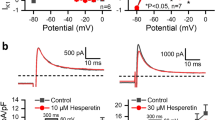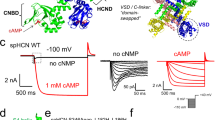Abstract
THE membrane of excitable tissue is capable of maintaining two different states, namely, either the resting state or the acting state. These two states are defined in terms of the membrane permeability to sodium and potassium ions; PNa/PK is small in the resting state whereas it is large in the acting state. Our recent experimental results suggest that the membrane potential may be dependent on the state of the membrane calcium which is probably located in a layer of lipoproteins1. In other words, the resting state of the membrane will be the condition in which calcium ions are associated with the membrane, and the acting state, the condition in which these ions are dissociated from the membrane. This concept is supported by the recent findings that PNa/PK is markedly increased when the membrane calcium is removed2. It is expected that the dissociation of the membrane calcium will be impeded when the concentration of calcium in the external solution is high, and accelerated when it is low or nullified, The membrane, therefore, will tend to stay in the resting state or acting state depending on the external concentration of calcium. Indeed, the excitable membrane is depolarized and often initiates action potentials spontaneously when the concentration of calcium in the external solution is reduced. Furthermore, it has recently been found that the action potential of frog's pinal ganglion cells is markedly prolonged in Ringer's solution containing no calcium ions3.
This is a preview of subscription content, access via your institution
Access options
Subscribe to this journal
Receive 51 print issues and online access
$199.00 per year
only $3.90 per issue
Buy this article
- Purchase on Springer Link
- Instant access to full article PDF
Prices may be subject to local taxes which are calculated during checkout
Similar content being viewed by others
References
Tobias, J. A., J. Cell. Comp. Physiol., 52, 89 (1958).
Kimizuka, H., and Koketsu, K., J. Gen. Physiol., 47, 379 (1963).
Koketsu, K., and Koyama, I., J. Physiol., 163, 1 (1962).
Tasaki, I., J. Physiol., 148, 306 (1959).
Koketsu, K., Cerf, J. A., and Nishi, S., J. Neurophysiol., 22, 177 (1959).
Tasaki, I., Nature, 184, 1574 (1959).
Spyropoulos, C. S., Amer. J. Physiol., 200, 203 (1961).
Author information
Authors and Affiliations
Rights and permissions
About this article
Cite this article
KOKETSU, K., NISHI, S. & SOEDA, H. Effects of Calcium Ions on Prolonged Action Potentials and Hyperpolarizing Responses. Nature 200, 786–787 (1963). https://doi.org/10.1038/200786a0
Issue Date:
DOI: https://doi.org/10.1038/200786a0
This article is cited by
-
Real-world evidence and optimization of vocal dysfunction in end-stage renal disease patients with secondary hyperparathyroidism
Scientific Reports (2021)
-
Physiological separation of Alzheimer’s disease and Alzheimer’s disease with significant levels of cerebrovascular symptomology and healthy controls
Medical & Biological Engineering & Computing (2021)
-
Rodent models for psychiatric disorders: problems and promises
Laboratory Animal Research (2020)
Comments
By submitting a comment you agree to abide by our Terms and Community Guidelines. If you find something abusive or that does not comply with our terms or guidelines please flag it as inappropriate.



